
Charles-Maurice de Talleyrand-Périgord, 1st Prince of Benevento, then Prince of Talleyrand, was a French secularised clergyman, statesman and leading diplomat. After studying theology, he became Agent-General of the Clergy in 1780. In 1789, just before the French Revolution, he became Bishop of Autun. He worked at the highest levels of successive French governments, most commonly as foreign minister or in some other diplomatic capacity. His career spanned the regimes of Louis XVI, the years of the French Revolution, Napoleon, Louis XVIII, and Louis Philippe I. Those Talleyrand served often distrusted him but, like Napoleon, found him extremely useful. The name "Talleyrand" has become a byword for crafty, cynical diplomacy.
Antoine René Charles Mathurin, comte de Laforêt was a senior French diplomat. He was Consul General of France to the United States before the French Revolution. During the First French Empire he was Ambassador in Madrid. He was briefly Minister of Foreign Affairs during the transitional government after the fall of Napoleon in 1814, and in 1815, after second abdication of Napoleon, a plenipotentiary to the Seventh Coalition powers.
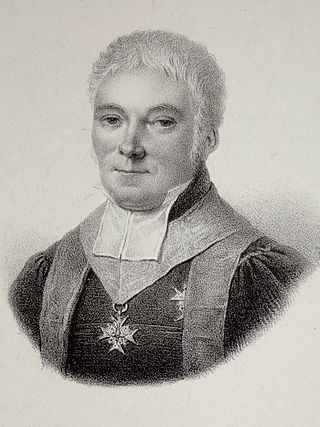
Charles Henry Dambray was chancellor of France, minister of justice, and president of the chamber of peers during the short lived restored French Royalist government of 1814 and 1815.

The Acte de déchéance de l'Empereur was a law passed by the Sénat conservateur on 2 April 1814, which deposed Napoleon I as Emperor of the French.

The First Cabinet of Napoleon I was appointed by the Emperor Napoleon I upon the establishment of the First French Empire on 18 May 1804, replacing the Cabinet of the Consulate. It was succeeded by the French Provisional Government of 1814 following the downfall of Napoleon and the abolition of the Empire.
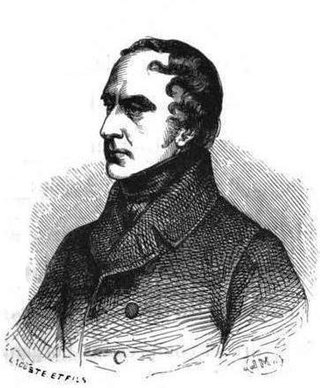
The Cabinet of François-Pierre Guizot was the last ministry of King Louis Philippe I of France, formed by decree of 19 September 1847. It replaced the Third cabinet of Nicolas Jean-de-Dieu Soult. It was dissolved when the Provisional Government was formed on 24 February 1848 after the February Revolution.
The Paris Municipal Commission Ministry of 1830 was proclaimed by the Paris Municipal Commission on 31 July 1830, after the revolution in which the Bourbon Restoration monarchy was deposed. One day later, it was replaced by a provisional government named by Louis Philippe I of Orléans.
The French Provisional Ministry of 1830 was announced on 1 August 1830 by Louis-Philippe d'Orléans in his capacity as Lieutenant General of the kingdom. It replaced the Paris Municipal Commission Ministry announced the day before after the revolution in which the Bourbon Restoration monarchy was deposed. On 11 August 1830 it was replaced by the First ministry of Louis-Philippe.
The First ministry of Louis-Philippe was announced on 11 August 1830 by King Louis Philippe I two days after he had become king. It replaced the Provisional Ministry announced on 1 August 1830. On 2 November 1830 it was replaced by the Cabinet of Jacques Laffitte.

The First cabinet of Adolphe Thiers was announced on 22 February 1836 by King Louis Philippe I. It replaced the Cabinet of Victor de Broglie.

Jean Lacave-Laplagne was a French magistrate and politician.

The Ministry of Casimir de Rochechouart de Mortemart was announced on 29 July 1830 by King Charles X of France during the last day of the Bourbon Restoration. Later that day the ministry was replaced by the Paris Municipal Commission.
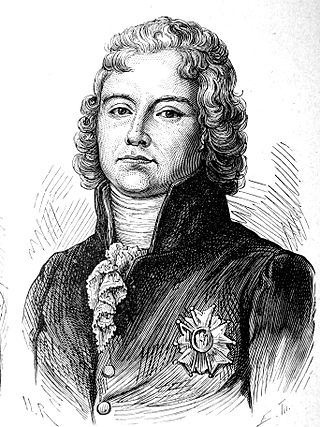
The Ministry of Charles-Maurice de Talleyrand-Périgord was formed on 9 July 1815 after the second Bourbon Restoration under King Louis XVIII of France. It replaced the French Provisional Government of 1815 that had been formed when Napoleon abdicated after the Battle of Waterloo. The cabinet was dissolved on 26 September 1815 and replaced by the First ministry of Armand-Emmanuel du Plessis de Richelieu.

The First ministry of Armand-Emmanuel du Plessis de Richelieu was formed on 26 September 1815 after the dismissal of the Ministry of Charles-Maurice de Talleyrand-Périgord by King Louis XVIII of France. It was dissolved on 29 December 1818 and replaced by the Ministry of Jean-Joseph Dessolles.
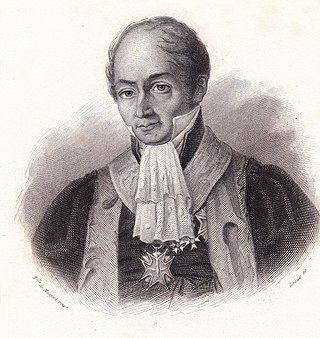
Pierre François Hercule de Serre was a French soldier, lawyer and politician. He was a deputy from 1815 to 1824, and was Minister of Justice in three successive cabinets from 1818 to 1821. He sat on the center-right, but had liberal views on press freedom, direct elections and the use of juries.
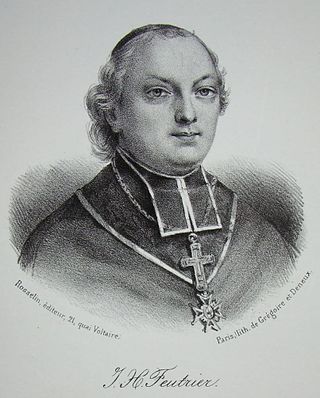
François-Jean-Hyacinthe Feutrier was a French Catholic priest who became Bishop of Beauvais. He was Minister of Religious Affairs from 3 March to 8 August 1829. He caused a storm of protest from the other bishops in France when he signed an ordinance aimed at restricting the influence of the church in schools.

The Government of the first Bourbon restoration replaced the French provisional government of 1814 that had been formed after the fall of Napoleon. It was announced on 13 May 1814 by King Louis XVIII. After the return of Napoleon from exile, the court fled to Ghent and the government was replaced by the French Government of the Hundred Days on 20 March 1815.

The French Government of the Hundred Days was formed by Napoleon I upon his resumption of the Imperial throne on 20 March 1815, replacing the government of the first Bourbon restoration which had been formed by King Louis XVIII the previous year. Following the defeat of Napoleon at the Battle of Waterloo and his second abdication on 22 June 1815 the Executive Commission of 1815 was formed as a new government, declaring the Empire abolished for a second time on 26 June.

The French Provisional Government or French Executive Commission of 1815 replaced the French government of the Hundred Days that had been formed by Napoleon after his return from exile on Elba. It was formed on 22 June 1815 after the abdication of Napoleon following his defeat at the Battle of Waterloo.

Pierre Paul Nicolas Henrion de Pansey was a French jurist and politician. He was briefly Minister of Justice in the French provisional government of 1814 formed after the defeat of Napoleon. He was one of the presidents of the Court of Cassation, a final court of appeal in France. He wrote several major works on jurisprudence.
















